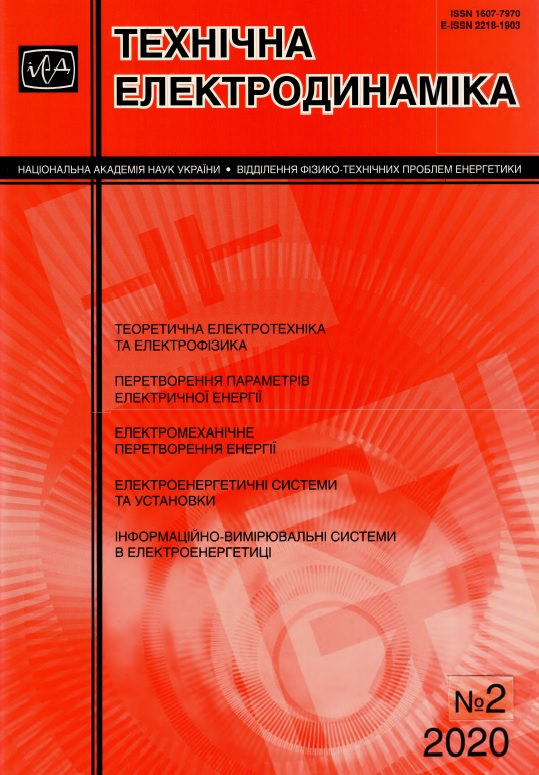Abstract
The use of printed windings in electric machines with permanent magnets and axial magnetic flux allows to reduce their axial size and significantly to increase the current density in the windings. Experimental studies of printed windings for heating confirmed that at a current density of J = 22 A / mm2, the steady-state temperature of the printed windings does not exceed 80 °C. For given dimensions of an electric machine with axial magnetic flux, permanent magnets and multilayer printed windings (outer diameter of the stator, axial length of the stator), numerical studies were carried out and the optimal thickness of the permanent magnets was determined at which the maximum value of the electromagnetic torque is reached. Also, as a result of numerical studies, it was found that the presence of teeth on the stator allows you to increase the electromagnetic torque of the electric machine by about 25% compared with the version of the magnetic system without teeth on the stator. A prototype of an electric machine with multilayer printed windings was made and the dependences of voltage and power in the generator mode were determined when connecting the windings through the rectifier diode bridge to the active load. The computational model of the generator adequately describes the physical model. The difference discrepancy between the calculated and experimental values does not exceed. It is shown that the average difference discrepancy between the experimental and calculated values does not exceed ε = 5.5%. The characteristics of the studied generators are calculated in the Simcenter MagNet and Simcenter MotorSolve software packages. References 10, figures 7, table 1.
References
Yan G., L. Hsu, J. Wang, M. Tsai and Wu X. Axial-Flux Permanent Magnet Brushless Motor for Slim Vortex Pumps. IEEE Transactions on Magnetics. 2009. Vol. 45. No 10. Pp. 4732-4735. DOI: https://doi.org/10.1109/TMAG.2009.2022499
Wu J. Design of a miniature axial flux flywheel motor with PCB winding for nanosatellites. International Conference on Optoelectronics and Microelectronics. Changchun. China. 23-25 Aug. 2012. Pp. 544-548. DOI: https://doi.org/10.1109/ICoOM.2012.6316334
Tsai M. and Hsu L. Design of a Miniature Axial-Flux Spindle Motor With Rhomboidal PCB Winding. IEEE Transactions on Magnetics. 2006. Vol. 42. No 10. Pp. 3488-3490. DOI: https://doi.org/10.1109/TMAG.2006.879438
Jang G. H. and Chang J. H. Development of an axial-gap spindle motor for computer hard disk drives using PCB winding and dual air gaps. IEEE Transactions on Magnetics. 2002. Vol. 38. No 5. Pp. 3297-3299. DOI: https://doi.org/10.1109/TMAG.2002.802292
Ying-Chi Chuo, Chien-Chang Wang, Chien-Sheng Liu, Hsing-Cheng Yu, Yu-Hsiu Chang and Ji-Bin Horng. Development of a miniature axial-field spindle motor. IEEE Transactions on Magnetics. 2005. Vol. 41. No 2. Pp. 974-976. DOI: https://doi.org/10.1109/TMAG.2004.842139
Neethu S., Nikam S. P., Singh S., Pal S., Wankhede A. K. and Fernandes B. G. High-Speed Coreless Axial-Flux Permanent-Magnet Motor With Printed Circuit Board Winding. IEEE Transactions on Industry Applications. 2019. Vol. 55. No 2. Pp. 1954-1962. DOI: https://doi.org/10.1109/TIA.2018.2872155
Wang X., Li C. and Lou F. Geometry Optimize of Printed Circuit Board Stator Winding in Coreless Axial Field Permanent Magnet Motor. 2016. IEEE Vehicle Power and Propulsion Conference (VPPC). 2016. Hangzhou. Pp. 1-6. DOI: https://doi.org/10.1109/VPPC.2016.7791695
Marignetti F., Volpe G., Mirimani S. M. and Cecati C. Electromagnetic Design and Modeling of a Two-Phase Axial-Flux Printed Circuit Board Motor. IEEE Transactions on Industrial Electronics. 2018. Vol. 65. No 1. Pp. 67-76. DOI: https://doi.org/10.1109/TIE.2017.2716865
ThinGap high power density brushless motors. URL: https://www.thingap.com/
Dobzhanskyi O., Hossain E., Amiri E., Gouws R., Grebenikov V., Mazurenko L., Pryjmak M. and Gamaliia R. Axial-Flux PM Disk Generator with Magnetic Gear for Oceanic Wave Energy Harvesting. IEEE Access. 2019. Vol. 7. Pp. 44813-44822. DOI: https://doi.org/10.1109/ACCESS.2019.2908348

This work is licensed under a Creative Commons Attribution-NonCommercial-NoDerivatives 4.0 International License.
Copyright (c) 2020 Array






